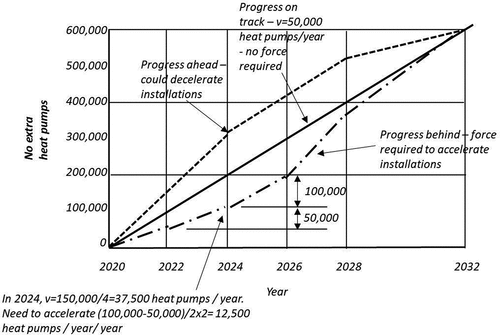Abstract
Principled capitalism has been proposed as a replacement for liberal capitalism. Moral principles should be driving our individual and collective decisions rather than utility and profit. A new unit called an oblig is suggested as a measure of the amount of the substance of the “stuff” that moves around in a social field of obligation forces. The notion of dynamic equilibrium is amplified and obligs are compared with the utils of utility theory and qualitative deposits in “emotional bank accounts”. It is concluded that the methods of utility theory are not appropriate for principled capitalism. A new unit of obligatory force is defined as a carson after the ecologist Rachel Carson. It is that force required to change the rate of change of a measured item within an obligation. The mathematics of obligs is developed and illustrated with four examples, two concerning individual relationships and two as applied to company and national government accounts.
Public Interest Statement
Principled capitalism has been proposed as a replacement for liberal capitalism. The key idea is that moral principles should be driving our individual and collective decisions. Neoclassical economics, as part of liberal capitalism, assumes that a consumer’s first concern is to maximize utility. The theory of obligations in principled capitalism is an engineering-systems perspective that aims to capture all forms of capital, financial, natural, social, and human. It is based on a new unit of oblig as a measure of the amount of the substance of the “stuff” that moves around in a complex social field of dynamic obligation forces—named as carsons after the ecologist Rachel Carson. The paper amplifies dynamic equilibrium. The measure obligs is compared with the utils of utility theory. A carson is that force required to change the rate of change of a measured item within an obligation. Four examples are used as illustrations.
1. Introduction
In a previous paper (Blockley 2021) I proposed a new theory of obligations as part of “principled capitalism”, suggested by Settle (Citation1976), designed to replace current liberal capitalism. Principled capitalism is founded on the idea that moral principles should be driving our individual and collective decisions rather than utility and profit. I introduced an oblig as a measure of the amount of the substance of the “stuff” that moves around in a social field of dynamic obligation forces. I distinguished Financial Exchange Worth (FEW), the current tradeable definition of Net Worth, from The Worth of Obligation (TWO), a non-tradeable concept which is centred on a set of obligations that a financial entity has to the natural world and to those aspects of our human and social world that are beyond FEW. TWO is a “bigger idea” than FEW with an importantly different moral stance from that of economic utility.
The purpose of this paper is fourfold. First, to amplify the notion of dynamic equilibrium in a field of social obligation forces. The second is to compare the new measure of obligs with the well-known and widely accepted units of utils in utility theory (Investopedia, Citation2019) and the more qualitative idea of deposits in “emotional bank accounts” as advocated by Covey (Citation1989); third, to develop further the mathematics of obligs and finally to provide some preliminary examples of how they might be used.
2. Dynamic equilibrium of economic forces
The theory of obligations in principled capitalism (Blockley, Citation2022a) is an engineering-systems perspective that aims to capture all forms of capital, financial, natural, social and human. It does so based on an oblig as a measure of the amount of the substance of the “stuff” that moves around in a social field att of dynamic obligation forces. The field att is complex, multidimensional, uncertain, and incomplete.
Neoclassical economics, as part of liberal capitalism, assumes that a consumer’s first concern is to maximize personal satisfaction. Rational purchasing decisions depend on evaluations of the utility of a product or service and market equilibrium arises from a balance of supply and demand (Investopedia, Citation2022). However, equilibrium is a tricky concept (Vijayamohanan Pillai, Citation2013). At its simplest static equilibrium occurs when economic forces are balanced. This is sufficient for some purposes, but the reality is much more complex. Economic variables are in a non-linear dynamic (ever changing) equilibrium state of flux (Puu, Citation2010). Deep uncertainties in the possible future constraints arise within and through the layers of economic systems by changes in participant behaviours and by economic and fiscal policies. These are both economic (such as investor confidence) and non-economic (such as climate change and pandemics). Consequently, equilibrium states within the economic field may change suddenly and radically.
Constraints generate economic forces (F) flowing between the entities—some internal and some external. Internal forces generate internal energy. Important forces have to be identified and controlled by the economist or political policy maker acting, in effect, as an economic design/control engineer. Where possible the engineer manipulates parameters of the systemic processes to do work (use energy) to move the system towards a desired outcome to fulfil a purpose—to find the “right path” to success however defined.
All systems, constrained or unconstrained, tend to move naturally to a state of equilibrium by losing internal energy, order and information content. Without external inputs of energy or matter, they move to a state that has minimal internal energy and maximum entropy (i.e., disorder). Entropy increases through dissipation, for example, through heat flow, wear, friction and damping in physical systems and from waste and unnecessary bureaucracy in social systems. When a constrained system is perturbed, it changes state. If it is in stable equilibrium then, after the perturbations, the system returns to the same state—the force, heat, chemical, obligational, and informational gradients between the system and its external environment are balanced. Static equilibrium is stable, reversible, and stationary. Dynamic equilibrium is stable, reversible, but changing. Unstable equilibrium is the condition when after a perturbation the system does not return to the same state but may move to a new state which may or may not be stable. Systems that are described as being “far from equilibrium”, are in an irreversible dynamic equilibrium state that is constantly changing in time. They are maintained only by flows of external energy and/or matter from outside (Day, Citation2003).
Different economic models make different assumptions about states of equilibrium. The test of the effectiveness of any model is whether it is “fit for purpose” and so the choice of model depends crucially on one’s purpose. The simplest model is that of a static equilibrium between demand and supply and may suffice for some problems. Models of dynamic equilibrium may assume various quantities growing at the same rate. All of these have been strongly criticised by Keen (Citation2013, Citation2022) and others who argue that economic models should utilise the latest developments in non-linear complex far from equilibrium systems.
Keen (Citation2013, Citation2022) has produced useful systems dynamics software, called Minsky, that simulates the behaviours within att assuming a far from equilibrium state. The dimensions of att are represented as a series of first order linear differential equations derived from Godley Tables (Keen, Citation2013) and various linear and non-linear parameters. These include consumption, government spending, labour productivity, population growth, lending, debt, interest, wages, consumption, and profit. He has demonstrated, for example quite clearly, how a growth of private debt to GDP preceded the 2007 financial collapse.
Keen (Citation2022b) has also proposed universal carbon credits (UCC) as a tradeable carbon currency and a way of rationing carbon. A carbon price on every product and service in the economy, allocated on an equal per-capita basis at a national level, implemented as a parallel currency would help to control the supply of fossil fuels at the point of extraction. UCCs are an example of a particular form of obligation but one expressed as FEW. It may be an example of how, in the long term, FEW might be replaced by a number of tradeable TWOs.
In summary, one can model an economic system as a progression of states each at an instant of time t on a multidimensional hyper-surface of an incomplete equation of state of net worth in a space of traditional system parameters att = (G, C, I, NX, etc.). G is government spending, C is consumption, I represents various interest rates and NX is net exports (Blockley, Citation2022a) but etc importantly includes a wide array of other factors such as current assets of cash reserves, noncurrent assets of property and equipment, current liabilities such as creditors and bills and non-current liabilities such as long-term loans and bonds which depend on interest rates (r), taxes (T) and economic and fiscal policies. The models can be conceived as a multidimensional hyper-surface with interactions that can be simulated or expressed in the form of matrix equations.
The central problem remains, however, and that is that all models of att are incomplete and uncertain. This makes using it to pursue any appropriate purpose, an engineering problem rather than a scientific one. The task of the economic engineer is to design and control or steer the path, through time, of points in att (the state of arrangements of assets and liabilities whether static, dynamic, near or far from equilibrium) to success, i.e., to do something useful. It is a task that relies on predictive models to inform but importantly is a problem not of scientific prediction but rather of engineering and management control under conditions of great uncertainty. It requires therefore a great deal of practical wisdom (Blockley, Citation2022)
3. Comparing obligations and utilities
The theories of obligations and utility are similar, in that they are attempts to capture consumption C within att, and the way people decide what economic and financial actions to take, but they are totally different in underlying values and concept.
Utility captures the amount of satisfaction received from consuming a good or service whereas obligation is the giving of a binding commitment, promise, pledge, contract, or sense of duty to act in good faith in accordance with our values of legitimate standards of trust honesty as upheld by the law.
Moscati (Citation2020) provides a history of utility theory from the early 1870s until today. Prior to that time the labour theory of value was used to model the exchange ratio between two commodities based on how much labour had been required. Moscati argues that the long-term resilience of the notion of utility from those early days seems in part due to its flexibility. Between 1870 and 1900 the idea lost it initially narrow identification with pleasure or need. It became a broadly defined concept capable of capturing any possible motivation for human action. In the 1980s a need emerged to unpack the diverse factors of this wider interpretation. Nevertheless, despite all the transformations, Moscati concluded that utility is a cornerstone of so much economic theory explain prices, market equilibria and other economic phenomena. Giocoli (Citation2003) investigated the shift in economics from rationality as maximisation to rationality as consistency. But he argued it had little to say about the meaning of economic equilibria for the analysis of real economic systems.
Now, economic theories based on rational choice usually assume that consumers will strive to maximize their utility. Utility is not intrinsic quality, rather it is essentially an appeal to individual and inward-looking selfishness. By contrast, an obligation is a degree of commitment, pledge or promise to treat others as you would have them treat you. It is essentially an appeal to group relationships and outward-looking sociability.
The unit of a util is the degree of satisfaction that a specific good or service generates for a subset of people in various situations or that a chosen course of action affords as judged by the chooser. It is contextual for example water is essential for life but not when someone is drowning, and an ice cream will have a larger number of utils in hot weather than in cold. Ordinal utils simply express rank choices by preferences—person A prefers X to Y for example, A prefers to eat a pizza rather than a burger. Cardinal utils are measures over a set of choices for example, A allocates 10 utils to eating pizzas and only 4 utils to eating a burger. Of course, in practice preferences may change and people may be (often are) irrational. Von Neumann and von Morgenstern (Citation1953) used game theory to develop a theory of the maximum expected utility. Faced with a set of choices an individual agent identifies the best and worst outcomes and allocates to them utils of 1 and 0. Any outcome between the best and worst has a probability of occurrence p. The value of p is determined by offering the chooser a bet in which she is indifferent between taking that outcome for sure or an outcome with probability p of the best outcome and (1-p) of the worst. The utility of that outcome is p. The expected (average) utility of all outcomes for each choice is used to decide between choices. The choice between bets to allocate utils is a therefore a thought experiment.
Such an experiment is not appropriate for allocating obligs however, since as stated earlier, the values underpinning these two measures are quite different—one aimed at the selfish interests of the consumer and the other aimed at the collective responsibilities and duties of care to others. Likewise, the uncertainty, as already alluded to, in any estimation is not straightforward and cannot be captured as a simple probability. Blockley (Citation2022) differentiates the grammatical or structural attributes of uncertainty from those of interpretation. Structural attributes are fuzziness, incompleteness, and randomness. Interpretive attributes are many but include ambiguity, dubiety, conflict, contingence and dependability. Ellsberg (Citation1961) identified evidence of an aversion to ambiguity. He thought it a paradox when decisions are inconsistent with expected utility theory. He found that a person tends to prefer choices with quantifiable risks over those with unknown, incalculable risks. Broome (Citation1991) has pointed out some ambiguities in the interpretation of utility between the use of utility as benefit or advantage, and that which is good and that which is useful. He refers to Sen (Citation1987) as using utility to refer to the good but as used by Sen it is unclear whether utility as a good is happiness, desire, well-being, or welfare. Broome concludes by proposing that utility should only be used to represent preference and not to imply the good.
I previously suggested (Blockley, Citation2022a) that the most appropriate and practical thought experiment to determine obligs is a vote—partly because that is the way complex and highly uncertain issues are determined in a democracy. Four logically entailed anchor points are apparent: must, should, could, and would like to (perhaps better expressed as ought) to make an obligation. For example, a [90–100] per cent vote is a must (one that is a necessity or required by law) obligation and would confer [90–100] obligs. A [70–90] per cent of a vote is a should obligation—one that is a strong expectation. [40–70] per cent of a vote is a could obligation—one that is a possibility. [10–40] per cent is an ought obligation—one that is an intention or inclination. Finally, [0–10] per cent of a vote represents no intention to fulfil an obligation.
An immediate question is who should vote? The constitution and size of the voting population must depend on the context. One alternative in representative democracy is to legally require our elected and appointed representatives to attach votes to all public decisions—including public accounts. Another approach for national and international issues such as global climate change, is to take a large sample size representative of the whole world. For smaller entities such as banks, companies, and local government authorities then the voting population could include shareholders, customers, employees, or stakeholders as deemed appropriate. At the level of individual decisions—people could make judgements by effectively allocating internal votes.
4. Obligs as the currency of an emotional bank account
Covey (Citation1989) uses the metaphor of an emotional bank account to describe the “amount of trust that’s been built up in a relationship”. The level of trust is created by making deposits of, for example, acts of honesty, kindness, unconditional love, and patience. Trust derives from being confident in the expectation of something and the basis for most that we do—the foundation on which our laws and contracts are built. It is the reason we are willing to pay for goods and services, to marry and to vote for someone who will represent our interests. It is also the input that makes it possible for leaders to create the conditions for employees to fully realize their own capacity and power. Trust is an essential part of social capital which creates hope and acts as the glue that holds society together. Social interaction and exchange without trust would be virtually impossible. The trustworthiness and credibility of an individual depends on reputation, track record of fulfilling on promises and obligations, on being fair, and not being exploitive. Overall trustworthiness of groups refers to norms and shared understandings. Frei and Morriss (Citation2020) say that the core drivers of trust in leaders are authenticity, logic, and empathy. People tend to trust you when they believe they are interacting with the real you (authenticity), when they have faith in your judgment and competence (logic), and when they feel that you care about them (empathy). Farid et al. (Citation2020) build on social exchange theory, which is a cost-benefit theory, to distinguish between affective-based trust that is relational, and cognitive-based trust that depends on the characteristics of a leader, such as ability, reliability, and integrity. Affective-based trust derives from a sense of responsibility to reciprocate and emphasize emotional ties between two parties building the security and strength of the relationship. Cognitive-based trust stems from the instrumental evaluation by the followers of their leaders’ character, action, and decision-making. Farid et al. state that “When followers perceive their leaders as authentic, they develop a strong sense of obligation and reciprocate by engaging more in citizen behaviours beyond their formal roles”. A formal obligation arises from a sense of duty to do something either through a binding promise or a contract. We can conclude that an obligation can therefore be informal, relational, and personal or it can be formal, legal and binding. We will call the first a relational obligation and the latter a contractual obligation.
In Covey’s (Citation1989) description of an emotional bank account each deposit or withdrawal is not necessarily an obligation. Nevertheless, when person A acts kindly to person B then person B will begin to feel obliged towards person A and vice versa. In other words, as the deposits and withdrawals are made, obligations are created. It seems reasonable to conclude that currency traded in an emotional bank account in the relationship between two people could, at least arguably, be captured by a measured number of obligs.
5. The mathematics of obligs
An oblig is an additive measure on the relation R between the set of possible actions X1, X2, X3 … ., consequent on the obligations of person A to person B. If A is obliged to B to do X only then the Relation R is RAB(X) and if X is the set (x1,x2,x3… .) then RAB(X) is defined on that set and obligs will be a measure over that relation set.
If A is obliged to B to do X and Y then the Relation R is defined on the cartesian product XxY and denoted RAB(XxY) and obligs will be a measure over that relation set (Figure ).
A vote for the level of obligation of A to B to do X and/or Y is then a measure on RAB(XxY) and is oblig(RAB(XxY)) = ∑ ∑ oblig(xi,yi). χxi,yi for all xi,yj
Note that the set indicator function or fuzzy membership function describes the logical relation between X and Y.
To illustrate this, see the Venn diagram of the two sets below (Figure ) for the intersection of X and Y which is X & Y.
This can be set out as the Relation RAB(XxY; (Figure ).
Likewise, the union X OR Y is shown in Figure .
And the implication relation X implies Y or X = > Y is in Figure .
6. The Force of an Obligation
The force of an obligation acting in the field of obligations is the force required to change the rate of uniform change (velocity) of a measured item within an obligation. We define this unit of obligatory force as a carson after the “ecologist and mother of conservation science” (Carson, Citation2011).
The measured item is the unit of measurement associated with an obligation. Examples of items include a set of defined events such as specific acts like building a certain number of houses or repairing a number of potholes in a road network, a number of biodiversity units bd in a hectare, a number of components n (such as heat pumps installed), a level of emissions such as MtCO2e, etc. A carson item is the unit of force required in an obligations force field to accelerate an ought obligation of 10 obligs at a rate of 1 item/year/year.
For example, if the local council promises to repair all the potholes in a given area (ha- hectares) then the obligation item is a pothole (ph/ha) and any obligation force required would be expressed as carson ph/ha. If the obligation is total (must) to repair 1,000 ph/ha in one year, then the obligation velocity is 1 kph/ha/year. If progress is uniform over the year, then the obligation acceleration and restoration force required will be zero. If progress is slow then the obligation acceleration and force to restore progress can be calculated as carson ph/ha (c.f. 100 newtons).
Example 1
Harold lives away from his family. He feels obliged to telephone his mother. The measured item of this obligation is ri (i = 1,3) a set of alternative acts to telephone his mother.
How many obligs does he feel he has in his emotional bank account with his mother and how will his telephoning change the balance?
The acts that he can take are that he should ring within a week (r1).
Or he must ring within 1 month (r2) and he ought to ring tomorrow (r3).
He could decide not to ring at all—but we will exclude that option.
Formally, the possible set of actions for Harold is T = {r1:1, r2:1, r3:1} where {ri; χi} is an {item; indicator function}
In Harold’s mind, depending on when he rings, he would have either a deposit 70 or 100 or 30 obligs in his emotional bank account with his mother. If he fails to ring at all (an alternative that we have excluded) then he will have withdrawn 100 obligs.
In other words, Harold’s obligation set to telephone his mother is oblig(T) = {r1:70, r2:100, r3:30} where {ri; χi} is an {item; indicator function*obligs}
Let’s assume Harold rings within a week then the actual action set is A = {r1: 1, r2:0, r3:0}
The outcome of his act (after ringing his mother) is the mathematical composition of A and T written AoT. The composition of two sets or two relations is like matrix multiplication where the minimum of two indicator functions replaces multiplication and maximum replaces addition.
In this simple case AoT = {r1:1, r2:0, r3:0} and oblig(T) = {r1:70, r2:0, r3: 0}. By ringing within a week Harold has deposited 70 obligs in his emotional obligation to his mother.
Of course, in such an everyday example, Harold would not write a balance sheet of obligations nor perform a mathematical calculation—the example serves only to illustrate.
When the set T contains more than one dimension (say X, Y) it becomes a Relation R on the Cartesian product XxY and the outcome is AoR as we will see in Example 2.
Example 2
Bert promises (and is therefore obliged to) Freda to repair her car and to test drive it. This is a 2-dimensional relational obligation, repair and test drive.
For mathematical brevity we designate Bert as A, Freda as B, repair car as X and test drive as Y.
Notice that Bert’s obligation is not reciprocal, i.e. Freda is not obliged to repair Bert’s car—though she may be obliged to repay him money or some gift such as to treat him to lunch.
Let us assume Bert finds that two repairs are needed so X is (x1,x2) where x1 is the event that engine idling needs adjusting, x2 is brakes needs adjusting. Bert will test drive for 1 km (y1 is true) or 2 km (y1 and y2 are true) depending on what he finds.
Let us assume that if he does a single adjustment (x1 or x2 are true, χ x1 = 1, χ x2 = 1) then he test drives for 2 km so (χ x1,y2 = 1, χ x2,y2 = 1). If he does not adjust anything he test drives 1 km (χ x1,y1 = 1, χ x2,y1 = 1).
The relation between repairs and test drive is RAB(XxY; Figure ) with an indicator function as shown
g. Bert necessarily test drives 1 km but drives 2 km if he adjusts something.
h. The cardinality (no of elements) of relation RAB(XxY) is 8.
i. RAB(XxY) presents Bert’s obligations to Freda (T in Example 1) and if he fulfills his obligation totally (A in Example 1) then it also represents the outcome and the composition AoT produces itself, i.e., RAB(XxY).
j. If RAB(XxY) represent 100 obligs as agreed between Freda and Bert then oblig(RAB(XxY)) = 100 obligs deposited as an asset in Bert’s emotional bank account with Freda. Freda, on the other hand, has a liability of 100 obligs in her account with Bert.
k. If Bert does not deliver on his promise, for example, he fails to test drive 2 km (χx1,y2 = χx2,y2 = 0) then the relation A changes and the cardinality of AoT drops to 6 carrying 75 obligs.
l. Freda’s obligation to Bert is captured in a similar but different relation. For example, if she pays him the market rate for car repairs then she deposits 100 obligs and both Bert and Freda’s accounts are in balance.
Example 3
Developer Ace Building plc are obliged to increase biodiversity bd on a site of 5 ha for 100 new houses. In this example, we define the size of a parameter p as a number with a lower size pl and an upper size pu and express it as p = [pl,pu]
The definition of a biodiversity unit (Natural England, Citation2021a) is that bdto = distinctiveness [0, 8] * condition [1, 3] * strategic significance [1, 1.15] before development. Ace must predict the biodiversity units after developing the site as bdt1* difficulty of creating or enhancing habitat [0.1, 1] * temporal risk [1, 0.32].
Therefore, the change in Δbd through developing the site is Δbd = bdt1- btd0
The maximum bd is 8*3*1.15 = 27.6. The minimum bd is 0. Consequently, the maximum range of Δbd = [0, 27.6]
The obligs measure on the Relation Rbd(t0xt1) is obligs(Rbd(t0xt1); (Figure ) as voted and agreed for these types of contract by the local government authority. Figure captures the obligations on Ace Building plc to deliver the promised changes. Positive obligs would be shown on the balance sheet as assets and negative obligs as liabilities.
If Ace Building plc promises to develop the site by Δbd in the range [0, 10], or [10, 20] or [20, 27] and the company delivers this promise then they can claim 100 obligs as an asset—they fulfilled their obligation.
If they fail to deliver, then they must show 100 obligs as a liability. They are not obliged to exceed their promise but if they turn [0, 10] into [10, 20] or [20, 27] they can show 70 obligs or 50 obligs as assets.
Clearly, we would wish to incentivize Ace Building plc to exceed their obligations. We would do that by offering financial incentives as Financial Exchange Worth (FEW; Blockley, Citation2022a) and these would be offered and recorded as financial transactions in the accounts.
Example 4
a. The HM Government UK (Citation2020) has obligated that the UK will deliver a ten-point plan fora Green Industrial Revolution by 2032.
b. The ten points are:
p1. Advancing offshore wind – current capacity from offshore wind is 14GW power. Theplan is to advance to 40GW by 2030 with private investment of £20bn and the saving of21MtCO2e (metric tons of carbon dioxide equivalent) on current usage of 2,500 MtCO2e.
p2. Growing low carbon hydrogen – build a capacity to produce 5GW of low carbonhydrogen with private investment of £4bn, saving 41MtCO2e by 2030
p3. Delivering new nuclear power – attract private investment of £300m
p4. Shifting to zero emission vehicles – install 2,500 high powered charging points, attractprivate investment of £3bn, saving 5MtCO2e by 2032
p5. Providing green public transport, cycling and walking – government to invest £5bn,create a national bus strategy, and save 2 MtCO2e by 2032
p6. Develop zero emission aviation and shipping – government to invest £35m, and save 1MtCO2e by 2032
p7. Providing greener buildings – install 600,000 heat pumps per year by 2028, withgovernment investment of £1bn, and private investment of £11bn, thus saving71 MtCO2e by 2032
p8. Investing in carbon capture – government to invest £1bn by 2025, thus saving 40MtCO2e by 2032.
p9. Protecting our natural environment – government to invest £5.2bn on flood defences,designate new National Parks and 10 landscape recovery projects.
p10. Innovating green finance – government to invest £1bn, attract £2.5bn privateinvestment and launch net zero innovation portfolio, fusion power demonstrator by 2022
c. Let us assume that each point pi contains j obligations p(i,j) so for example, p(7,1) is (thegovernment will install 600,000 heat pumps per year by 2028) and p(7,2) is (government willinvest £1bn into providing greener buildings by 2032) and p(7,3) is (the government will attract£11bn of private investment by 2032) and p(7,4) is (the government will save 71 MtCO2e by2032).
d. We can construct a relation on the Cartesian product of p(ij) x time t as Rp(ij)xt . We can allocate obligs to each p(ij),t by, say, a Parliamentary vote, to produce for example, Figure for p(7,i). Notice there is no obligation to deliver by 2024 but we could incentivize delivery earlier if we wished to by other means.
e. In a complex example such as this, it is imperative to track progress year by year (Figure )and identify the level of action forces required to bring progress back on track. For example,progress on obligation p(7,1) could be as shown in the figure. If as is likely progress is behind schedule, then the obligation force required to get back on track is obligs*d(p(7,1))/dt.
f. For example, imagine that in 2024 only 800,000 heat pumps have been installed when the government had promised with a must obligation of 100 obligs that their target was to install 1,600,000. The projected velocity needed to get to 1,600,000 heat pumps by 2026 is 1,100,000/4 = 275,000 heat pumps/year accelerated at 125,000 heat pumps/year/year. Without such an acceleration progress to keep on track will worsen. The obligation force to achieve the acceleration with a must obligation is 12,500,000 obligs heat pumps/year/year.
g. Another analysis in 2025 will then be required to find a new acceleration to continue reducing the gap between performance and target in subsequent years. This would be an ongoing process of reviews and adjustments to steer the government to a publicly transparent success (or otherwise) in 2028.
h. The obligation force could be expressed in carson heat pumps/yr by assuming the carson quantity is 100,000 heat pumps/yr and noting the obligation is a must of 100 obligs then the force is (75,000/100,000) * (10/100) = 12.50 carson heat pumps/yr.
i. This kind of analysis of government planning brings a possible clarity to the process that may/may not be attractive to our political leaders. Perhaps, part of the lack of trust shown by many members of the electorate in their elected representatives derives from ambiguity and/or a lack of clarity over whether obligations have or have not been delivered. This is perhaps at its most important when monitoring progress on promises made by governments in the developed world to help nations in the developing world react to climate change. It is at least arguable that the kind of clarity brought by the suggested use of obligs will serve to build trust in the emotional bank account between politicians and the people.
7. Future Developments in measures of uncertainty of obligs
The suggestions made in this paper are tentative. They require much further development and more rigorous testing in a practical use of voting where there are wide variations in levels and types of uncertainty. Blockley (Citation2009) has discussed the nature of uncertainty from first principles, to consider its various manifestations in an attempt to improve the making of decisions. Six kinds of uncertainty were identified under the headings of truth, trust, clarity, changeableness, incompleteness, and risk. Truth and changeableness (together as one kind) with clarity and completeness are three central attributes of information, and trust is central to the making of decisions by experts. They all are ingredients of the main task of managing and controlling risk. Reductionism has been successful for the analysis of hard (physical) systems, but soft (social, psychological) systems are governed by the behaviour of people which is so complex as to be hard to define and difficult to analyze. The emphasis in soft systems therefore should not be on prediction but rather on managing a process to achieve desired outcomes based on dependable evidence—which is context dependent. Processes are the way things behave in hard systems and what people do in soft systems. Blockley and Godfrey (Citation2017) and Blockley (Citation2022b) describe a methodology for mapping uncertainty to a so-called Italian Flag of evidence. The flag is a colourful way of capturing the dependability of the evidence for making a decision towards a stated purpose and could possibly be used in a voting process. It consists of three probability intervals on the scale [0, 1]. The interval [0, g] coloured green is the degree of evidence for where g is a lower bound probability of the evidence being dependable. The white interval [g, 1-r] is the “don’t know” or incompleteness of the evidence. Finally, the interval [1-r, 1] is the red evidence against.
The next stage of the research described here is to use the Italian Flag measure of the dependability of obligs towards a particular purpose as described in the examples given above—such as protecting diversity or achieving government policies by voting. This could better inform the ongoing day-to-day decision-making process about current aspects of evidence and particularly where there needs to be perhaps further evidence gathering or discussion. This is particularly so when there are high levels of various kinds of uncertainty, with multiple stakeholders in different locations and companies.
8. Conclusions
Principled capitalism is founded on the idea that moral principles should be driving our individual and collective decisions rather than utility and profit. To facilitate that I have previously proposed a theory of obligation. The theories of obligations and utility are similar in that they are attempts to capture the way people decide what economic and financial actions to take but they are totally different in underlying values and concept. Utility captures the amount of satisfaction received from consuming a good or service whereas obligation is the giving of a binding promise, contract, or sense of duty to act in good faith in accordance with our values of legitimate standards of trust honesty as upheld by the law. With its emphasis on usefulness and satisfaction utility theory together with the thought experiments to capture the units of utils are not appropriate for principled capitalism. Rather than rely on a util it is concluded that an oblig is a way of capturing the amount of the substance of the “stuff” that moves around in a social field of obligation forces. Voting is suggested as the basis for a thought experiment to measure obligs. Suggestions are included for the composition of voting electorates for different contexts.
Principled capitalism based on mutual obligations relies on trust—an essential part of social capital. Trust creates hope and acts as the glue that holds society together. Covey’s emotional bank account describes the amount of trust that has been built in a relationship. Affective-based trust is distinguished from cognitive-based trust. The former is informal and relational and the latter formal and contractual. Both could be measured as obligs within a new mathematics of obligation.
In the proposed mathematics, an oblig is an additive measure on the relation R between the set of possible actions X1, X2, X3 … ., consequent on the obligations of person A to person B. The force of an obligation acts in the field of obligations and is that which is required to change the rate of uniform change of a measured item within an obligation. This unit of obligatory force is named as a carson after the “ecologist and mother of conservation science” (Carson, Citation2011). The measured item is the unit of measurement associated with an obligation. Examples of items include a set of defined events such as a set of specific acts like building a certain number of houses or repairing a number of potholes in a road network or improving a number of biodiversity units bd in a hectare.
Four examples of the potential use of obligs have been described. The first two concern informal exchanges of obligations between individuals—included not to suggest they should be used in everyday life, rather simply to illustrate the processes involved. The second two concern a formal use of obligs that could be included in company and public accounts to motivate an increase in biodiversity and to clarify the progress of the UK governments promised 10-point plan for a Green Industrial Revolution by 2032. Finally, I have speculated that future research could focus on attempts to use the “Italian Flag” method of assessing uncertain evidence in a voting process.
Declaration Statement
The author has no competing interests to declare and no relevant financial or non-financial interests to disclose.
Disclosure statement
No potential conflict of interest was reported by the authors.
References
- Blockley, D. (2009). Uncertainty – Prediction or Control? International Journal of Engineering under Uncertainty, 1, 1–15. (last accessed September 2022 https://www.researchgate.net/profile/David-Blockley/publication/259363561_Uncertainty_-_Prediction_or_Control/links/57c057fe08ae2f5eb3321e35/Uncertainty-Prediction-or-Control.pdf
- Blockley, D. (2022). Practical wisdom in an age of computerisation. See https://www.tandfonline.com/doi/abs/10 .1080/10286608.2020.1810675 ( See. Civil Engineering and Environment Systems, 37(4), 197–213.
- Blockley, D. (2022a). Exchanging obligations: Accounting for all forms of capital. Journal Interdisciplinary Economics. March (last accessed April 2022a. 026010792210817. https://doi.org/10.1177/02601079221081717
- Blockley, D. (2022b). Building bridges: Between theory and practice. World Scientific, (See Figure 8.1 p174)
- Blockley, D., & Godfrey, P. (2017). Doing it differently: Systems for rethinking infrastructure. ICE Pubs.
- Broome, J. (1991). Utility. Economics and Philosophy, 7(1), 1–12. “Utility” (cambridge.org) (last accessed September 2020). https://doi.org/10.1017/S0266267100000882.
- Carson, R. (2011) Rachel Carson, The Life and Legacy (last accessed October 2021)
- Covey, S. R. (1989). The 7 Habits of Highly Effective People. Simon & Schuster.
- Day, R. H. (2003). Economics far from equilibrium. In Day, R.H (ed.) Chapter 11 of the divergent dynamics of economic growth studies in adaptive economizing, technological change, and economic development (pp. 203–220). Cambridge University Press. https://doi.org/10.1017/CBO9780511510700.012
- Ellsberg, D. (1961). Risk, ambiguity, and the savage axioms. Quarterly Journal of Economics, 75(4), 643. https://doi.org/10.2307/1884324
- Farid, T., Iqbal, S., Khan, A., Ma, J., Khattak, A., & Din, M. N. U. (2020). The impact of authentic leadership on organizational citizenship behaviours: the mediating role of affective‐ and cognitive-based trust. Frontiers in Psychology. https://doi.org/10.3389/fpsyg.2020.01975
- Frei, F. X., & Morriss, A. (2020) Begin with trust, Harvard business review see everything starts with trust (hbr.org). Harvard Business Review. (last Accessed October 2021)
- Giocoli, N. (2003). Modeling Rational Agents. Edward Elgar Publishing.
- HM Government UK. (2020) The ten point plan for a green industrial revolution the ten point plan for a green industrial revolution (publishing.service.gov.uk) (last accessed October 2021)
- Investopedia. (2019) Utility Function, See https://www.investopedia.com/ask/answers/072915/what-utility-function-and-how-it-calculated.asp
- Investopedia. (2022) Economic Equilibrium, See https://www.investopedia.com/terms/e/economic-equilibrium.asp
- Keen, S. (2013). A monetary Minsky model of the great moderation and the great recession. Journal of Economic Behavior and Organization, 86, 221–235. https://doi.org/10.1016/j.jebo.2011.01.010
- Keen, S. (2022a). The New Economics. Polity Press:
- Keen, S., (2022b) Universal Carbon Credits as a Carbon Currency. https://ecocore.org/proposal/ (last accessed April 2022b)
- Moscati, I. (2020) History of Utility Theory, Working Paper N. 129, The Social Science Research Network Electronic Paper Collection, January. See https://papers.ssrn.com/sol3/papers.cfm?Abstract_id=3530949 (last accessed September 2020)
- Natural England. (2021a) Biodiversity Metric 3.0 User Guide, See http://nepubprod.appspot.com/publication/6049804846366720 (last accessed October 2021a)
- Natural England. (2021b) Biodiversity Metric 3.0 User Guide, See http://nepubprod.appspot.com/publication/6049804846366720 (last accessed October 2021b)
- Neumann, J., & von Morgenstern, O. (1953). Theory of games and economic behaviour. NJ. Princeton University Press.
- Puu, T., (2010) Nonlinear economic dynamics and global analysis, Chapter 1 of Nonlinear Economic Dynamics Nova Science Publishers Inc. https://www.researchgate.net/publication/261361702_Nonlinear_economic_dynamics_and_global_analysis
- Sen, A. (1987). On Ethics and Economics. Blackwell Publishing.
- Settle, T. (1976). In Search of a Third Way. McClelland & Stewart Ltd.
- Vijayamohanan Pillai, N., (2013) General Equilibrium: A Critique. https://www.researchgate.net/publication/273145777

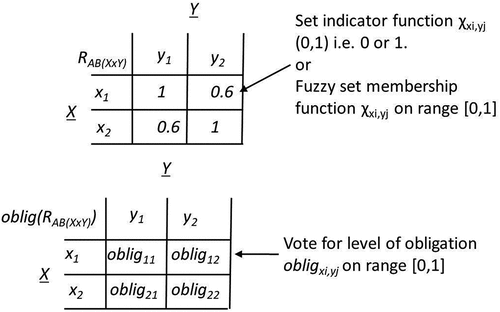
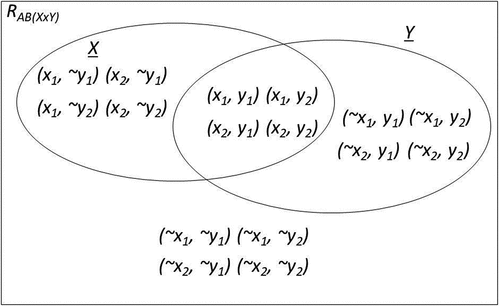
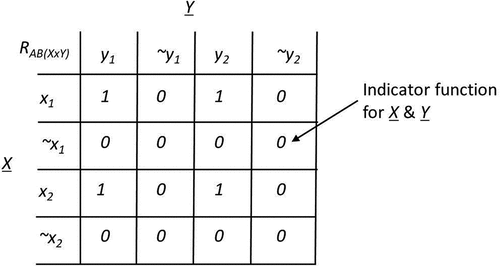
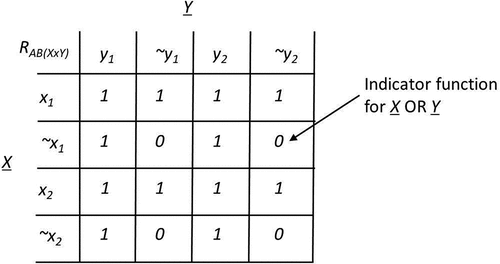
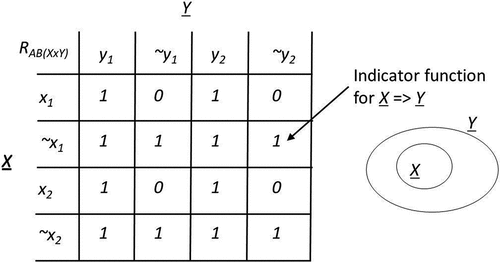

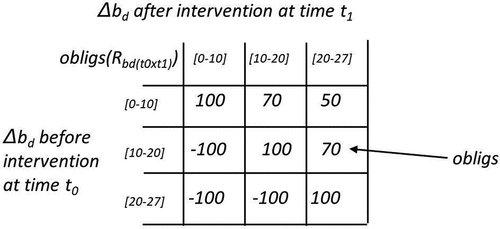
![Figure 8. Relation obligs(Rp(7,i)xt) for i = [1,4] in Example 4 Point 7.](/cms/asset/35bc67b3-479e-4c36-be0d-31975cd5c893/oabm_a_2154101_f0008_b.gif)
